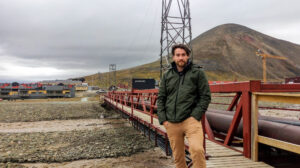Bryan presented EU project outcomes at Svalbard: “The challenges that are faced by the Longyearbyen community are directly related to many of our projects”
By Mari Kristine Buckholm 4. September 2020
Before the summer holidays, Smart Innovation Norway researcher Bryan Pellerin went to the world’s northernmost urban community to promote exploitation from some of the company’s large research and innovation projects.
Smart Innovation Norway and UiT – The Arctic University of Norway have been research partners for several years. UiT is a member of the NCE Smart Energy Markets cluster and has rich research experience from Arctic areas.
This summer, Smart Innovation Norway senior researcher within renewable energy, Bryan Pellerin, was invited by UiT to the island realm of Svalbard to convey the work that has been done in different Horizon 2020 projects and that can be relevant to the Longyearbyen community.
“I exchanged with a variety of very motivated actors pioneering the energy transition in Arctic regions. I am optimistic that we will maintain a strong collaboration in transferring practical results from applied research and innovation projects to the energy challenges faced in Longyearbyen,” says Pellerin.
Towards decarbonization
As one of the northernmost settlements on Earth, Svalbard is the focal point of international research in climate issues. The polar regions are experiencing drastic effects of climate change, and the eyes of the world are using it as a test ground to better understand the transformation the planet is undergoing.
eyes of the world are using it as a test ground to better understand the transformation the planet is undergoing.
“Within this context, Longyearbyen, the region’s largest settlement is transitioning away from its traditional coal-driven past. This energy transition is a small-scale representation of the realities of many places around the globe which are pursuing efforts towards decarbonization. The challenges that are faced by the Longyearbyen community are directly related to many of the projects in which Smart Innovation Norway is involved,” explains Pellerin.
For that reason, he travelled to meet with representatives from the local government and different industry stakeholders to discuss some of the project outcomes that are relevant for their challenges, in hopes to help them benefit from the results.
End-user strategies from E-LAND
One of the most relevant projects is the EU Horizon 2020 E-LAND project, in which Smart innovation Norway acts as scientific coordinator. The project develops and demonstrates novel solutions to decarbonize energy islands.
“These areas which don’t benefit from strong connections to the mainland power system have particular challenges in achieving this transition away from carbon-intensive energy sources. The E-LAND project adopts strategies for optimizing the flow of energy across different carriers in multi-vector energy systems, also known as sector-coupling,” informs Pellerin.
He believes these strategies are particularly relevant in Longyearbyen, which is a true multi-vector energy system, where a mix of electric distribution and district heat networks provide energy to the town’s residents and visitors.
“It was fruitful to discuss with local actors in how to utilize some of the end-user strategies from E-LAND in the context of Longyearbyen,” comments Pellerin – who will continue to work with Svalbard representatives to implement solutions from Smart Innovation Norway research projects.
Who is Smart Innovation Norway?Smart Innovation Norway is an innovation platform within the fields of Smart Energy, Smart Cities and Digitalization. The platform consists of five business areas and the company is an interplay between those. Smart Innovation Norway is a cluster of industries and academic institutions within Smart Grid and Smart Energy Market Research and Innovation. Smart Innovation Norway develops smart and sustainable solutions through research-based innovation and business development. Core business is techno-economic models and analysis, business intelligence, prosumers and user flexibility. |
||
Social media
E-LAND updates

The E-LAND project aims to develop and demonstrate tools for energy systems to overcome the technical, business, and societal challenges associated with the creation of… (1 year ago)

E-LAND exploitation enhancement activities kickstarted for the final project year Multiple events were executed and many more are planned for the E-LAND project’s final year.… (1 year ago)

A central pillar of the E-LAND project's is risk management. The Norwegian consortium member, Institute for Energy Technology (IFE), implemented a risk management approach to… (2 years ago)

E-LAND H2020 is working with creating a toolbox that is designed to optimize and control multi-energy islands and isolated communities. The toolbox is structured in… (2 years ago)

Smart Innovation Norway together with the University of St. Gallen have developed a series of workshops that began in June 2021 and focused on the… (2 years ago)

About the pilot site: Port of Borg is situated in an industrial area on a small peninsula called Øra just outside Fredrikstad, Norway. Port work… (2 years ago)

Since the mid-1960s, the township of Auroville in Southern India has been striving for sustainable living and the realization of human unity in diversity. In… (2 years ago)